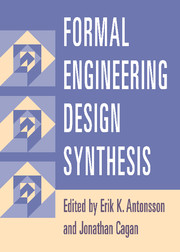Book contents
- Frontmatter
- Contents
- Contributing Authors
- Foreword
- Preface
- Introduction
- 1 Vitruvius Redux
- 2 How to Calculate with Shapes
- 3 Engineering Shape Grammars
- 4 Creating Structural Configurations
- 5 Microsystem Design Synthesis
- 6 Function-Based Synthesis Methods in Engineering Design
- 7 Artificial Intelligence for Design
- 8 Evolutionary and Adaptive Synthesis Methods
- 9 Kinematic Synthesis
- 10 Systematic Chemical Process Synthesis
- 11 Synthesis of Analog and Mixed-Signal Integrated Electronic Circuits
- 12 Mechanical Design Compilers
- 13 Scientific Discovery and Inventive Engineering Design
- Index
4 - Creating Structural Configurations
Published online by Cambridge University Press: 10 October 2009
- Frontmatter
- Contents
- Contributing Authors
- Foreword
- Preface
- Introduction
- 1 Vitruvius Redux
- 2 How to Calculate with Shapes
- 3 Engineering Shape Grammars
- 4 Creating Structural Configurations
- 5 Microsystem Design Synthesis
- 6 Function-Based Synthesis Methods in Engineering Design
- 7 Artificial Intelligence for Design
- 8 Evolutionary and Adaptive Synthesis Methods
- 9 Kinematic Synthesis
- 10 Systematic Chemical Process Synthesis
- 11 Synthesis of Analog and Mixed-Signal Integrated Electronic Circuits
- 12 Mechanical Design Compilers
- 13 Scientific Discovery and Inventive Engineering Design
- Index
Summary
INTRODUCTION
Objects with a physical existence in space must embody a structure that provides support for the mechanical function of the object, namely, dealing with mechanical loads, forces, and moments. In biological objects, structure usually is classified as endoskeletal or exoskeletal, see Figure 4.1. Endoskeletal structures provide an “internal skeleton” or a frame to which the rest of the object is essentially attached, like the bodies of humans and other vertebrates. Exoskeletal structures provide an “external skeleton” or shell within which the rest of the object is contained, like the body of a crab and other crustaceans. Inorganic object structures can be classified the same way. Early automobile designs used a frame-chassis structure to which everything was attached. More recent designs use a single (unibody or monocoque) main shell structure, whereas most recently a return to endoskeletal structures is being explored, combining metal frames with plastic or composite panels. The choice of structure clearly depends on many factors, including material use and operating environments.
Designing the structure of an artifact is probably the earliest engineering design task undertaken – building a tool, a shelter, or a bridge. For several reasons, structural design remains an important and challenging task. One challenge is designing a structure that meets not only behavioral criteria (load support and transfer) but also other requirements, for example, accessibility, manufacturability, and aesthetics. A second challenge is proper material use, recognizing that material properties often vary or are not precisely known.
- Type
- Chapter
- Information
- Formal Engineering Design Synthesis , pp. 93 - 125Publisher: Cambridge University PressPrint publication year: 2001
- 3
- Cited by



